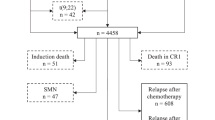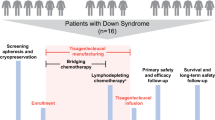Abstract
Clinical characteristics, treatment response and outcome were evaluated in children with Down’s syndrome (DS) and acute lymphoblastic leukemia (ALL) as compared to other children with ALL (NDS). Sixty-one DS and 4049 NDS patients, receiving intensive antileukemic treatment during four consecutive trials (ALL-BFM 81, 83, 86 and 90) of the Berlin–Frankfurt–Münster Group (BFM), were retrospectively analyzed. DS and NDS children did not differ with respect to sex, leukocyte count, CNS leukemia and cytogenetic translocations. The DS cohort was slightly older (P = 0.04), presented predominantly with the common while lacking the T immunophenotype (P = 0.005), had a lower frequency of hyperdiploidy (P = 0.004) and tended to have a better initial steroid response (P = 0.057). Therapy-associated morbidity especially during high-dose methotrexate and a subsequent need for treatment modification occurred in 43% of all DS patients. Event-free survival (EFS) was slightly worse in children with DS (58 ± 8% vs 70 ± 1%, P = 0.14), mainly due to rather late bone marrow recurrences. However, EFS in DS patients was comparable to the NDS group once they either received treatment with no major modifications (65 ± 9% vs 70 ± 1%, P = 0.66) or were <6 years of age, irrespectively of therapy modifications (73 ± 9% vs 74 ± 1%, P = 0.7). Cox regression analysis revealed that DS was an adverse prognostic factor for patients having completed therapy (P = 0.0107), but was not prognostic at diagnosis (P = 0.103). Age ⩾6 years, suboptimal treatment and infectious problems contributed to the slight inferior EFS in children with ALL and Down’s syndrome. Therefore, most of these patients can be successfully treated if receiving intensive antileukemic treatment with no major modifications, but they require more sophisticated management of toxicity.
This is a preview of subscription content, access via your institution
Access options
Subscribe to this journal
Receive 12 print issues and online access
$259.00 per year
only $21.58 per issue
Buy this article
- Purchase on Springer Link
- Instant access to full article PDF
Prices may be subject to local taxes which are calculated during checkout
Similar content being viewed by others
Author information
Authors and Affiliations
Consortia
Rights and permissions
About this article
Cite this article
Dördelmann, M., Schrappe, M., Reiter, A. et al. Down’s syndrome in childhood acute lymphoblastic leukemia: clinical characteristics and treatment outcome in four consecutive BFM trials. Leukemia 12, 645–651 (1998). https://doi.org/10.1038/sj.leu.2400989
Received:
Accepted:
Published:
Issue Date:
DOI: https://doi.org/10.1038/sj.leu.2400989
Keywords
This article is cited by
-
The journey to CAR T cell therapy: the pediatric and young adult experience with relapsed or refractory B-ALL
Blood Cancer Journal (2019)
-
Child and adolescent Down syndrome-associated leukaemia: the Irish experience
Irish Journal of Medical Science (1971 -) (2015)
-
Clinical and genetic features of pediatric acute lymphoblastic leukemia in Down syndrome in the Nordic countries
Journal of Hematology & Oncology (2014)
-
Akute lymphoblastische Leukämien (ALL) im Kindes- und Jugendalter
Monatsschrift Kinderheilkunde (2013)
-
Outcome in children with Down's syndrome and acute lymphoblastic leukemia: role of IKZF1 deletions and CRLF2 aberrations
Leukemia (2012)



